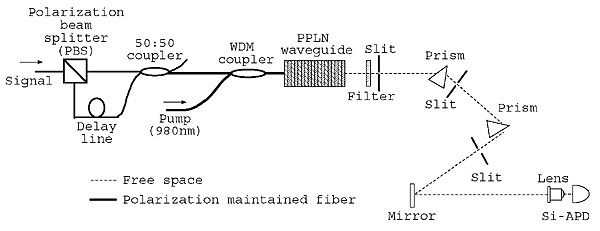Hidehiko Kamada1, Yoshiki Nishida3, Osamu Tadanaga3, Masaki Asobe3, and Kyo Inoue4
1Optical Science Laboratory, 2NTT Network Innovation Laboratories,
3NTT Photonics Laboratories, 4Osaka University/NTT Research Professor
Quantum key distribution (QKD) has been studied as a way to realize
unconditionally secure communications. We had been intensively working
on differential-phase-shift QKD (DPS-QKD) experiment where randomly phase-modulated
coherent pulse stream was used [1, 2]. Recently, we performed a field trial
of DPS-QKD using polarization independent frequency up-conversion detectors
to show the feasibility of our QKD scheme [3].
In this experiment, a sender generated a 1-GHz coherent pulse stream,
and each pulse was randomly phase-modulated by 0,π. The pulse was attenuated
to 0.2 photons per pulse and then transmitted to a receiver's site over
the 17.6-km installed fiber. At the receiver's site, the pulse stream was
input into a planar lightwave circuit Mach-Zehnder interferometer. The
output ports of the interferometer were connected to the polarization independent
up-conversion detectors. Figure 1 shows the setup of our detector. A signal
pulse (photon) was input into a polarization beam splitter (PBS), which
split the polarization of the incoming photon into horizontally and vertically
polarized pulses. The horizontally polarized pulse was directly input into
a 50:50 coupler. The vertically polarized pulse was input into a fiber
delay line as a horizontally polarized pulse. After 50:50 coupler, horizontally
polarized pulses were combined with a strong pump light, and injected into
a periodically poled lithium niobate (PPLN) waveguide. In the PPLN waveguide,
a 600 nm photon was generated via the sum frequency generation (SFG) process.
After suppressing the pump, the SFG photon was detected with a single photon
counting module (SPCM) based on a Si-APD. The detected signals were input
into a time interval analyzer to record the photon detection events.
With this setup, we performed a long-term stability test. We successfully
demonstrated stable operation for 6 hours and achieved a sifted key generation
rate of 120 kbps and an average quantum bit error rate of 3.14 %, which
revealed the feasibility of our QKD scheme.
This research was supported in part by National Institute of Information
and Communications Technology of Japan.
[1] K. Inoue, et al., Phys. Rev. A 68 (2003) 022317.
[2] H. Takesue, et al., New J. Phys. 7 (2005) 232.
[3] T. Honjo, et al., Opt. Express 15 (2007) 15920.
 |
||
|